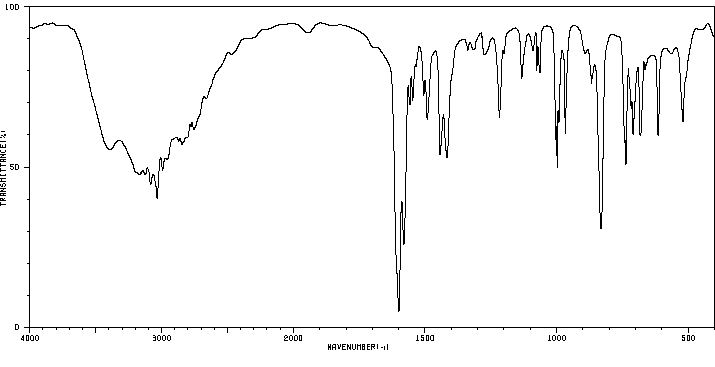4,4,4-(1H-咪唑-2,4,5-三基)三吡啶 | 23974-93-8
中文名称
4,4,4-(1H-咪唑-2,4,5-三基)三吡啶
中文别名
——
英文名称
2,4,5-tris(4-pyridinyl)imidazole
英文别名
2,4,5-tri(4-pyridyl)imidazole;2,4,5-tris(4-pyridyl)imidazole;2,4,5-tris(pyridin-4-yl)imidazole;2,4,5-tri(4-pyridyl)-1H-imidazole;2,4,5-tris(4-pyridyl)-1H-imidazole;4,4',4''-(1H-imidazole-2,4,5-triyl)tripyridine;4-(2,4-dipyridin-4-yl-1H-imidazol-5-yl)pyridine
CAS
23974-93-8
化学式
C18H13N5
mdl
——
分子量
299.335
InChiKey
YJOAHXHOXMAHOG-UHFFFAOYSA-N
BEILSTEIN
——
EINECS
——
-
物化性质
-
计算性质
-
ADMET
-
安全信息
-
SDS
-
制备方法与用途
-
上下游信息
-
文献信息
-
表征谱图
-
同类化合物
-
相关功能分类
-
相关结构分类
物化性质
-
熔点:>300 °C
-
沸点:558.9±50.0 °C(Predicted)
-
密度:1.265±0.06 g/cm3(Predicted)
计算性质
-
辛醇/水分配系数(LogP):1.8
-
重原子数:23
-
可旋转键数:3
-
环数:4.0
-
sp3杂化的碳原子比例:0.0
-
拓扑面积:67.4
-
氢给体数:1
-
氢受体数:4
安全信息
-
危险性防范说明:P261,P280,P301+P312,P302+P352,P305+P351+P338
-
危险性描述:H302,H315,H319,H335
-
储存条件:存放在2-8℃的环境中,应保持干燥并密封。
SDS
反应信息
-
作为反应物:描述:4,4,4-(1H-咪唑-2,4,5-三基)三吡啶 在 盐酸 作用下, 以 乙醇 为溶剂, 反应 0.25h, 生成 2,4,5-tris(4-pyridyl)imidazole hydrogen chloride参考文献:名称:2,4,5-三(4-吡啶基)咪唑氯化氢的晶体结构、Hirshfeld表面、DFT计算和光物理性质摘要:摘要 制备了 2,4,5-三(2-吡啶基)咪唑 (TPI) 的氯化氢盐,即 [HTPI]Cl (1),并通过红外、紫外-可见和荧光光谱、高分辨率、质谱、热重分析 (TGA)、差示扫描量热法 (DSC) 和单晶 X 射线衍射 (scXRD) 分析通过检查 Hirshfeld 表面完成。分子晶体盐在固态下表现出有趣的蓝色光致发光,这也在 EtOH/THF 溶液中实现,最大发射对应于 1:3 (v/v) 溶剂混合物。固态结构中的超分子相互作用以 N–H⋯Cl− 和 C–H⋯N/Cl− 氢键为特征,给出了二维层结构,在第三维中由 π⋅⋅⋅π 相互作用完成。基于结构表征和 Hirshfeld 表面分析,假设 π 接触在具有抗溶剂 THF 的乙醇溶液中也占主导地位。根据模拟乙醇溶剂环境的 M06-2X/6-31G(d) 理论水平的 TD-DFT 计算表明,发射特性源自 π−π∗ 和 n−π∗ HOMO→LUMODOI:10.1016/j.molstruc.2020.128175
-
作为产物:描述:4-氰基吡啶 在 ((1,2-bis(diisopropylphosphino)ethane)NiH)2 、 氢气 作用下, 180.0 ℃ 、827.39 kPa 条件下, 反应 48.0h, 以91%的产率得到4,4,4-(1H-咪唑-2,4,5-三基)三吡啶参考文献:名称:用镍催化剂从芳族腈一锅法合成咪唑。摘要:使用苄腈,对位取代的苄腈和4-氰基吡啶作为起始原料,可使用镍(0)催化剂以高至高收率生产取代的咪唑。DOI:10.1039/c1cc13497c
文献信息
-
Stereospecific diaza-Cope rearrangement as an efficient tool for the synthesis of DPEDA pyridine analogs and related C<sub>2</sub>-symmetric organocatalysts作者:A. S. Kucherenko、A. A. Kostenko、V. V. Gerasimchuk、S. G. ZlotinDOI:10.1039/c7ob01852e日期:——A simple and efficient synthesis of enantiomerically pure (1S,2S)-1,2-di(pyridin-2-yl)- and (1R,2R)-1,2-di(pyridin-4-yl)-ethane-1,2-diamines from commercial picolinaldehyde or isonicotinaldehyde and 2,2′-((1S,2S)-1,2-diaminoethane-1,2-diyl)diphenol (HPEN) via a stereospecific diaza-Cope rearrangement has been developed. Diamine (R,R)-2b was readily converted to novel diastereomeric ionic group-supported对映体纯的(1 S,2 S)-1,2-二(吡啶-2-基)-和(1 R,2 R)-1,2-二(吡啶-4-基)的简单有效的合成-乙烷-1,2-二胺从商业吡啶甲醛或异烟醛和2,2' - ((1-小号,2小号)-1,2-二氨基乙烷-1,2-二基)联苯酚(HPEN)通过立体有择二氮杂-应对重排已开发。二胺(R,R)-2b易于转化为新型非对映体离子基团支持的双脯氨酰胺(R,S)-1b和(R,R)-图1b似乎是在纯净条件下在醛/醛,酮/酮或酮/醛试剂体系中不对称交叉醛醇缩合反应的有效有机催化剂,以高收率和高达99%的ee提供相应的醛醇缩合。此外,催化剂(R,S)-1b可在相同或相似的催化反应中重复使用超过15次,表现出接近原始的活性和高水平的立体诱导。
-
Two new helical compounds based on Keggin clusters and N-donor multidentate ligand: Syntheses, structures and properties作者:Shi Zhou、Bo Liu、Xiao-Min Li、Tian Shi、Ya-Guang ChenDOI:10.1016/j.jssc.2014.07.005日期:2014.11Two isostructural polyoxometalate-based inorganic–organic hybrids with 1D helical chain, [CuH3L2(GeMo12O40)]·2H2O (1) and [CuH3L2(SiMo12O40)]·2H2O (2), where L=2,4,5-tri(4-pyridyl)-imidazole have been synthesized under hydrothermal conditions. It is the first time to use the L ligand to synthesis the Keggin-type polyoxometalate-based inorganic–organic hybrids. The two compounds possess the left- and两个具有一维螺旋链的基于多金属氧酸盐的异结构杂化体,[CuH 3 L 2(GeMo 12 O 40)]·2H 2 O(1)和[CuH 3 L 2(SiMo 12 O 40)]·2H 2 O (2),其中L= 2,4,5-三(4-吡啶基)-咪唑是在水热条件下合成的。这是第一次使用L配体来合成基于Keggin型多金属氧酸盐的无机-有机杂化物。这两种化合物均具有左旋和右旋螺旋链,而POM则通过Cu-O键连接到悬垂的螺旋链中。这两种化合物已通过元素分析,红外(IR)光谱,粉末X射线衍射(PXRD),X射线光电子能谱(XPS),热重分析(TGA)和光致发光光谱进行了表征。此外,已经研究了氮吸附-解吸测量,在化合物1的UV辐射下降解亚甲基蓝(MB)的电化学和光催化性能。
-
Modulated preparation and structural diversification of metal–organic frameworks based on 4,4′,4″-(1H-imidazole-2,4,5-triyl)tripyridine ligand作者:Jun-Jie Wang、Ren-Chun Zhang、Dao-Jun Zhang、Yun-Feng Shi、Ying-Hui Zhang、Xiao-Li Lu、Er-Ni Wang、Feng JinDOI:10.1016/j.ica.2015.01.010日期:2015.3Abstract Four metal–organic frameworks with 4,4′,4″-(1 H -imidazole-2,4,5-triyl)tripyridine (Htpim), namely [Cu 4 (tpim) 4 ](DMAC)(H 2 O) 3 } ∞ ( 1 ), [Cu(H 2 tpim) 2 (H 2 O) 2 ](NO 3 ) 4 (H 2 O) 2 } ∞ ( 2 ), [Zn(Htpim) 2 (H 2 O) 2 ](NO 3 ) 2 (H 2 O) 5 } ∞ ( 3 ) and [Zn(Htpim)(NO 3 )(H 2 O)](NO 3 )} ∞ ( 4 ) (DMAC = N,N-dimethylacetamide), have been prepared under solvothermal conditions. Single摘要具有4,4',4''-(1 H-咪唑-2,4,5-三基)三吡啶(Htpim)的四个金属有机骨架,即[Cu 4(tpim)4](DMAC)(H 2 O)3}∞(1),[Cu(H 2 tpim)2(H 2 O)2](NO 3)4(H 2 O)2}∞(2),[Zn(Htpim)2( H 2 O)2](NO 3)2(H 2 O)5}∞(3)和[Zn(Htpim)(NO 3)(H 2 O)](NO 3)}∞(4)(DMAC = N,N-二甲基乙酰胺),是在溶剂热条件下制备的。单晶X射线衍射分析表明,配体Htpim分别采用1的离子化形式,2的质子化形式和3和4的初级形式,并具有三种类型的结合模式,包括μ2 -N py,N py模式。在2和3中,μ3 -N py,N py,N im模式在1中和μ3 -N py,N py,N py模式在4中。不同的网络结构,即1的2D 3,4-连接的4.6 2}
-
Luminescent coordination polymers constructed using a mixed-ligand strategy for highly selective luminescence sensing of nitrobenzene, Fe<sup>3+</sup> and Cr<sub>2</sub>O<sub>7</sub><sup>2−</sup> ions and photodegradation of rhodamine B作者:Jun-Jie Wang、Fei-Fan Wu、Ning Su、Pan-Pan Li、Si-Yin Wang、Hui-Yan Ma、Yun-Wu Li、Mei-Hui YuDOI:10.1039/d0ce00677g日期:——5-benzenetetracarboxylic acid) were constructed. Compounds 1–4 and 7–9 have similar 2D 44 networks, while 5, 6 and 10 show 1D chain structures. The results reveal that the coordination configuration of M(II), carboxylic acids, and coordinated water molecules play pivotal roles in the formation of the final structures. Moreover, the selective luminescence sensing and photocatalytic performances of 1–10 were使用混合配体策略,十种新的发光配位聚合物(LCP),即[Cd(IPA-NH 2)(Htpim)] n(1),[Mn(IPA-NH 2)(Htpim)] n(2) ,[Zn(IPA-OH)(Htpim)] n(3),[Cd(IPA-OH)(Htpim)] n(4),[Zn(Htpim)2(H 2 O)2 ](IPA- OH)} n(5),[Cd(Htpim)2(H 2 O)2 ](IPA-OH)} n(6),[Cd(IPA-NO 2)(Htpim)] n(7),[Zn 2(PMA)(Htpim)2 ] n(8),[Cd 2(PMA)(Htpim)2 ] n(9)和[Cu(H 2 PMA)(Htpim)2(H 2 O)] n(10)(Htpim = 2,4,5-三(4-吡啶基)-咪唑,H 2 IPA-NH 2 = 5-氨基间苯二甲酸,H 2 IPA-OH = 5-羟基间苯二甲酸,H 2制备了IPA-NO
-
Supramolecular isomerism, single-crystal to single-crystal transformation induced by release of in situ generated I2 between two supramolecular frameworks作者:Xing Meng、Xue-Zhi Song、Shu-Yan Song、Sheng-Qun Su、Min Zhu、Zhao-Min Hao、Shu-Na Zhao、Hong-Jie ZhangDOI:10.1039/c3dt50183c日期:——Two supramolecular isomers, [H2tpim·H4betc]·I (1) and [H2tpim·H4betc]·I3·2H2O (2), have been synthesized by one-pot reactions. Single-crystal to single-crystal transformations are observed between the two supramolecular isomers which are induced by release of in situ generated I2.通过一锅反应合成了[H2tpim-H4betc]-I(1)和[H2tpim-H4betc]-I3-2H2O(2)两种超分子异构体。在这两种超分子异构体之间观察到了单晶到单晶的转化,这种转化是由原位生成的 I2 的释放诱导的。
表征谱图
-
氢谱1HNMR
-
质谱MS
-
碳谱13CNMR
-
红外IR
-
拉曼Raman
-
峰位数据
-
峰位匹配
-
表征信息
同类化合物
(SP-4-1)-二氯双(1-苯基-1H-咪唑-κN3)-钯
(5aS,6R,9S,9aR)-5a,6,7,8,9,9a-六氢-6,11,11-三甲基-2-(2,3,4,5,6-五氟苯基)-6,9-甲基-4H-[1,2,4]三唑[3,4-c][1,4]苯并恶嗪四氟硼酸酯
(5-氨基-1,3,4-噻二唑-2-基)甲醇
齐墩果-2,12-二烯[2,3-d]异恶唑-28-酸
黄曲霉毒素H1
高效液相卡套柱
非昔硝唑
非布索坦杂质Z19
非布索坦杂质T
非布索坦杂质K
非布索坦杂质E
非布索坦杂质D
非布索坦杂质67
非布索坦杂质65
非布索坦杂质64
非布索坦杂质61
非布索坦代谢物67M-4
非布索坦代谢物67M-2
非布索坦代谢物 67M-1
非布索坦-D9
非布索坦
非唑拉明
雷非那酮-d7
雷西那德杂质2
雷西纳德杂质L
雷西纳德杂质H
雷西纳德杂质B
雷西纳德
雷西奈德杂质
阿西司特
阿莫奈韦
阿考替胺杂质9
阿米苯唑
阿米特罗13C2,15N2
阿瑞匹坦杂质
阿格列扎
阿扎司特
阿尔吡登
阿塔鲁伦中间体
阿培利司N-1
阿哌沙班杂质26
阿哌沙班杂质15
阿可替尼
阿作莫兰
阿佐塞米
镁(2+)(Z)-4'-羟基-3'-甲氧基肉桂酸酯
锌1,2-二甲基咪唑二氯化物
锌(II)(苯甲醇)(四苯基卟啉)
锌(II)(正丁醇)(四苯基卟啉)
锌(II)(异丁醇)(四苯基卟啉)








